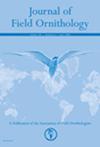求助PDF
{"title":"一种低成本,易于制造,便携式的鸟类咬力传感器","authors":"Julieta Carril, Federico J. Degrange, Ricardo S. De Mendoza, Claudia P. Tambussi","doi":"10.1111/jofo.12387","DOIUrl":null,"url":null,"abstract":"<div>\n \n <p>Few investigators have examined <i>in vivo</i> bite-force of birds, likely due, at least in part, to the difficulty in accessing suitable force transducers. We describe a low-cost, easy-to-build, and portable force transducer with the goal of encouraging ornithologists to improve our knowledge of <i>in vivo</i> bite forces of birds. We used a commercial piezo-resistive force sensor (Tekscan<sup>©</sup>) to construct our transducer, and measure the bite forces of captive birds with different beak morphologies, including the following species: Greater Rhea (<i>Rhea americana</i>), Black-chested Buzzard-Eagle (<i>Geranoaetus melanoleucus</i>), King Vulture (<i>Sarcoramphus papa</i>), Toco Toucan (<i>Ramphastos toco</i>), and Graylag Goose (<i>Anser anser</i>). Bite forces ranged from 25.1 N for the Toco Toucan to 109.9 N for the King Vulture. By using the bite forces obtained in our study and those reported for other birds in the literature, a regression analysis was performed, revealing that half of the variation in bite force is explained by allometry, with other factors such as beak morphology likely explaining the remaining variation. Our bite-force transducer should allow researchers to obtain low-cost, reliable bite-force data, which will improve our understanding of the relationship between form and function of the avian cranio-mandibular complex.</p>\n </div>","PeriodicalId":15785,"journal":{"name":"Journal of Field Ornithology","volume":"92 4","pages":"485-491"},"PeriodicalIF":0.7000,"publicationDate":"2021-12-16","publicationTypes":"Journal Article","fieldsOfStudy":null,"isOpenAccess":false,"openAccessPdf":"","citationCount":"1","resultStr":"{\"title\":\"A low-cost, easy-to-build, and portable bite-force transducer for birds\",\"authors\":\"Julieta Carril, Federico J. Degrange, Ricardo S. De Mendoza, Claudia P. Tambussi\",\"doi\":\"10.1111/jofo.12387\",\"DOIUrl\":null,\"url\":null,\"abstract\":\"<div>\\n \\n <p>Few investigators have examined <i>in vivo</i> bite-force of birds, likely due, at least in part, to the difficulty in accessing suitable force transducers. We describe a low-cost, easy-to-build, and portable force transducer with the goal of encouraging ornithologists to improve our knowledge of <i>in vivo</i> bite forces of birds. We used a commercial piezo-resistive force sensor (Tekscan<sup>©</sup>) to construct our transducer, and measure the bite forces of captive birds with different beak morphologies, including the following species: Greater Rhea (<i>Rhea americana</i>), Black-chested Buzzard-Eagle (<i>Geranoaetus melanoleucus</i>), King Vulture (<i>Sarcoramphus papa</i>), Toco Toucan (<i>Ramphastos toco</i>), and Graylag Goose (<i>Anser anser</i>). Bite forces ranged from 25.1 N for the Toco Toucan to 109.9 N for the King Vulture. By using the bite forces obtained in our study and those reported for other birds in the literature, a regression analysis was performed, revealing that half of the variation in bite force is explained by allometry, with other factors such as beak morphology likely explaining the remaining variation. Our bite-force transducer should allow researchers to obtain low-cost, reliable bite-force data, which will improve our understanding of the relationship between form and function of the avian cranio-mandibular complex.</p>\\n </div>\",\"PeriodicalId\":15785,\"journal\":{\"name\":\"Journal of Field Ornithology\",\"volume\":\"92 4\",\"pages\":\"485-491\"},\"PeriodicalIF\":0.7000,\"publicationDate\":\"2021-12-16\",\"publicationTypes\":\"Journal Article\",\"fieldsOfStudy\":null,\"isOpenAccess\":false,\"openAccessPdf\":\"\",\"citationCount\":\"1\",\"resultStr\":null,\"platform\":\"Semanticscholar\",\"paperid\":null,\"PeriodicalName\":\"Journal of Field Ornithology\",\"FirstCategoryId\":\"99\",\"ListUrlMain\":\"https://onlinelibrary.wiley.com/doi/10.1111/jofo.12387\",\"RegionNum\":4,\"RegionCategory\":\"生物学\",\"ArticlePicture\":[],\"TitleCN\":null,\"AbstractTextCN\":null,\"PMCID\":null,\"EPubDate\":\"\",\"PubModel\":\"\",\"JCR\":\"Q3\",\"JCRName\":\"ORNITHOLOGY\",\"Score\":null,\"Total\":0}","platform":"Semanticscholar","paperid":null,"PeriodicalName":"Journal of Field Ornithology","FirstCategoryId":"99","ListUrlMain":"https://onlinelibrary.wiley.com/doi/10.1111/jofo.12387","RegionNum":4,"RegionCategory":"生物学","ArticlePicture":[],"TitleCN":null,"AbstractTextCN":null,"PMCID":null,"EPubDate":"","PubModel":"","JCR":"Q3","JCRName":"ORNITHOLOGY","Score":null,"Total":0}
引用次数: 1
引用
批量引用


